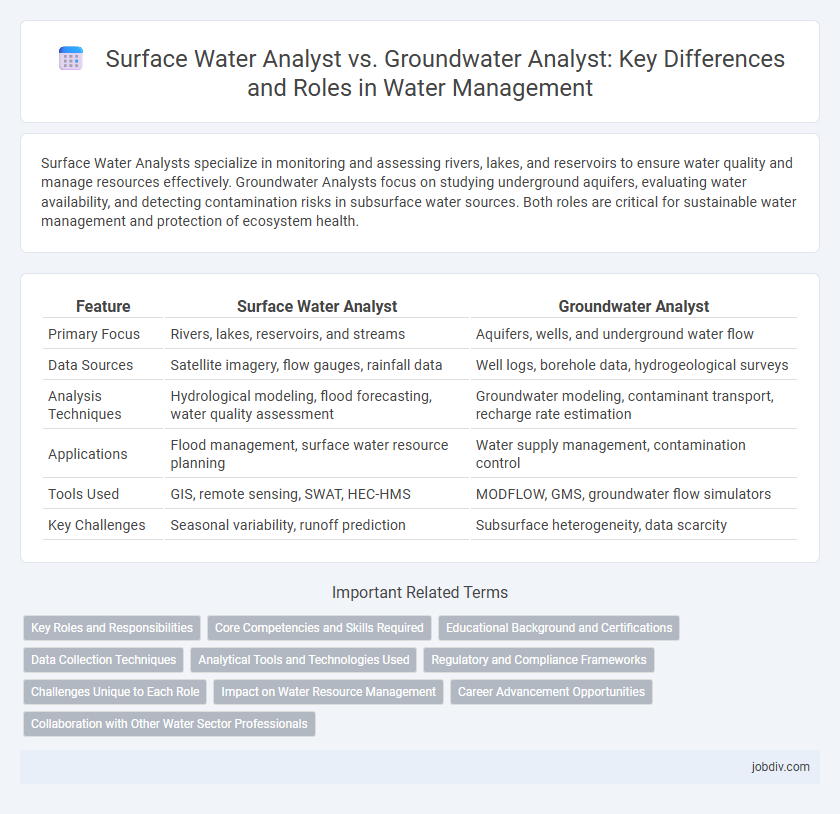Surface Water Analysts specialize in monitoring and assessing rivers, lakes, and reservoirs to ensure water quality and manage resources effectively. Groundwater Analysts focus on studying underground aquifers, evaluating water availability, and detecting contamination risks in subsurface water sources. Both roles are critical for sustainable water management and protection of ecosystem health.
Table of Comparison
| Feature | Surface Water Analyst | Groundwater Analyst |
|---|---|---|
| Primary Focus | Rivers, lakes, reservoirs, and streams | Aquifers, wells, and underground water flow |
| Data Sources | Satellite imagery, flow gauges, rainfall data | Well logs, borehole data, hydrogeological surveys |
| Analysis Techniques | Hydrological modeling, flood forecasting, water quality assessment | Groundwater modeling, contaminant transport, recharge rate estimation |
| Applications | Flood management, surface water resource planning | Water supply management, contamination control |
| Tools Used | GIS, remote sensing, SWAT, HEC-HMS | MODFLOW, GMS, groundwater flow simulators |
| Key Challenges | Seasonal variability, runoff prediction | Subsurface heterogeneity, data scarcity |
Key Roles and Responsibilities
Surface Water Analysts monitor and evaluate water quality, flow rates, and pollutant levels in rivers, lakes, and reservoirs to support environmental compliance and resource management. Groundwater Analysts specialize in assessing aquifer conditions, groundwater recharge, contamination risks, and the impact of extraction on subsurface water resources. Both roles require expertise in hydrological modeling, data interpretation, and regulatory standards to ensure sustainable water resource management.
Core Competencies and Skills Required
Surface Water Analysts specialize in hydrology, river and stream flow analysis, and watershed management, requiring proficiency in Geographic Information Systems (GIS), remote sensing, and hydrological modeling software like HEC-RAS and SWAT. Groundwater Analysts focus on aquifer characterization, groundwater flow modeling, and contaminant transport, demanding expertise in hydrogeology, well drilling techniques, and software such as MODFLOW and Visual MODFLOW. Both roles require strong data analysis, environmental regulations knowledge, and field sampling techniques, but differ primarily in their specialized software tools and core hydrological processes.
Educational Background and Certifications
Surface Water Analysts typically hold degrees in hydrology, environmental science, or civil engineering, emphasizing surface water dynamics, watershed management, and fluvial processes. Groundwater Analysts often pursue education in hydrogeology, geology, or environmental engineering, focusing on aquifer properties, groundwater flow, and contaminant transport. Certifications such as Certified Hydrogeologist (CHG) for Groundwater Analysts and Professional Hydrologist (PH) or Certified Water Treatment Operator for Surface Water Analysts enhance professional credibility and technical expertise.
Data Collection Techniques
Surface Water Analysts primarily use stream gauging, remote sensing, and hydrological modeling to collect data on river flow, precipitation, and surface runoff. Groundwater Analysts rely on techniques such as well logging, aquifer testing, and groundwater sampling to measure water quality, hydraulic conductivity, and aquifer levels. Both roles utilize Geographic Information Systems (GIS) for spatial data integration but focus on distinct environments requiring specialized instrumentation and methodologies.
Analytical Tools and Technologies Used
Surface Water Analysts utilize remote sensing technologies, GIS mapping, and hydrological modeling software to monitor and analyze river flows, lake levels, and runoff patterns. Groundwater Analysts employ geophysical tools like electrical resistivity tomography, groundwater flow models, and water quality sensors to assess aquifer properties and contamination levels. Both roles rely on advanced data analytics and simulation software to support water resource management and environmental impact assessments.
Regulatory and Compliance Frameworks
Surface Water Analysts focus on monitoring and managing rivers, lakes, and reservoirs within regulatory frameworks such as the Clean Water Act, ensuring compliance with water quality standards and discharge permits. Groundwater Analysts work under regulations like the Safe Drinking Water Act and state-specific groundwater protection laws, assessing aquifer contamination and groundwater extraction limits. Both roles require detailed knowledge of Environmental Protection Agency (EPA) guidelines and coordination with local water management agencies to enforce sustainable water resource use.
Challenges Unique to Each Role
Surface Water Analysts face challenges such as managing the variability of river flow rates, monitoring pollutant levels affected by rainfall and runoff, and addressing the impacts of urbanization on water quality. Groundwater Analysts contend with difficulties in accurately mapping subsurface aquifers, assessing contamination from underground sources, and predicting long-term recharge rates amid changing climatic conditions. Both roles require specialized techniques for sampling, data interpretation, and modeling to ensure sustainable water resource management.
Impact on Water Resource Management
Surface Water Analysts evaluate rivers, lakes, and reservoirs to monitor quality, flow rates, and pollutant levels, directly influencing flood control and irrigation strategies. Groundwater Analysts focus on aquifer conditions, recharge rates, and contamination risks, critical for sustainable groundwater extraction and preventing overuse. Both roles complement each other in integrated water resource management by addressing surface and subsurface water dynamics essential for long-term availability.
Career Advancement Opportunities
Surface water analysts often find career advancement opportunities in environmental consulting firms, government agencies, and water resource management organizations where expertise in lakes, rivers, and reservoirs is critical. Groundwater analysts tend to advance through roles involving hydrogeology, contamination assessment, and aquifer management, often working with environmental protection agencies and private sector industries specializing in subsurface water studies. Both career paths offer specialization prospects, with surface water analysts focusing on watershed modeling and flood risk, while groundwater analysts concentrate on well monitoring and remediation technologies.
Collaboration with Other Water Sector Professionals
Surface Water Analysts collaborate closely with hydrologists, environmental engineers, and urban planners to monitor river flows, manage flood risks, and design sustainable water management systems. Groundwater Analysts work alongside hydrogeologists, geotechnical engineers, and regulatory authorities to assess aquifer health, predict contamination spread, and develop groundwater recharge strategies. Together, these professionals form an integrated water resource management team, ensuring comprehensive analysis of both surface and subsurface water systems for effective water sustainability.
Surface Water Analyst vs Groundwater Analyst Infographic

 jobdiv.com
jobdiv.com